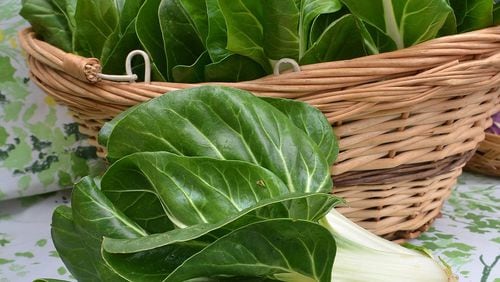Farmers are just as interested in growing something new as we are in trying out a delicious new vegetable. Linda Scharko of Scharko Farms says she waited two months to get her hands on the seeds for Barese chard, an heirloom Italian variety of the vegetable we think of as “Swiss” chard.
“The seed catalogs said it would be a good substitute for the choys. We find the choys are tasty, but the worms and bugs think they’re tasty, too, and they’re susceptible to lots of damage from bugs. We were looking for something that would grow well over the winter and provide us with a pretty green to take to market.”
The “we” is Linda and her husband Tony. They’ve just been honored with Georgia Organics’ 2017 Barbara Petit Pollinator Award for their decades of hands-on farming and mentoring future farmers in the Georgia area. The couple farms on 4 acres just a few blocks from historic downtown Fairburn.
<<Where to find 2017 metro Atlanta farmers markets
<<More recipes to make right now
Scharko has been bringing Barese chard to her customers at the year-round Saturday morning Peachtree City Farmers Market. She even carries a container-grown plant with her so her customers can see what it looks like growing.
The Scharkos planted about 400 row feet of this new variety, seeding thickly. Within about six weeks they were able to start cutting down smaller plants and bringing those to market, leaving the other plants to grow on uncrowded.
The farm is planting more for spring and expects to have plenty for the customers of their community-supported agriculture program that began March 1 and for shoppers at the seasonal East Atlanta Village Farmers Market when it opens April 13.
She finds this new variety of chard works well as both a salad green and a cooking green. The leaf texture is a little sturdier than that of Swiss chard, resembling fresh spinach leaves as much as anything. The stems are about an inch wide and white. They’re tender, but they take a little longer to cook than the leaves, so for some preparations, you’ll want to cook them separately.
Barese Chard Gratin
My introduction to Swiss chard came many years ago in the pages of “Mastering the Art of French Cooking, Volume II” by Julia Child and Simone Beck. Back then, it was a completely new vegetable to me. Now it’s at every farmers market and grocery store, most often in the form of the colorful “Rainbow” variety.
I’ve adapted the Child/Beck version which is still my favorite no matter what the chard. I think it’s prettiest with the green and white of Barese chard.
1 pound Barese chard (about 4 heads)
3 cups water, divided
1/4 cup all-purpose flour
Juice of 1 lemon (optional)
1/4 cup heavy cream
1 egg yolk
Salt and pepper
1/4 cup Parmesan
1 tablespoon unsalted butter
Prepare the chard by cutting off the green leaves and roughly chopping. Set aside. Trim the stem ends and cut the white stalks into 1/4-inch slices.
In a medium saucepan, whisk together 1 cup water and flour. Heat over medium heat and gradually add remaining 2 cups water, whisking to reduce the chance of lumps. Add lemon juice, if using. When mixture begins to simmer, add chard stem pieces and cook 20 minutes or until tender. Add leaf pieces and cook until tender, about 5 minutes.
Preheat broiler. Lightly grease an 8-by-8-inch baking dish.
In a small bowl, whisk together cream and egg yolk. Stirring constantly, add to the hot vegetable mixture and simmer until sauce thickens. Taste for seasoning. Pour mixture into baking dish and sprinkle with Parmesan. Dot with bits of butter and broil just until top begins to brown. Remove from oven and let sit 5 minutes before serving. Serves: 6
Per serving: 111 calories (percent of calories from fat, 59), 4 grams protein, 8 grams carbohydrates, 1 gram fiber, 8 grams fat (4 grams saturated), 57 milligrams cholesterol, 263 milligrams sodium.
AT LOCAL FARMERS MARKETS
For sale
Vegetables and fruit just coming to market: onions, potatoes
Vegetables, fruits and nuts: apples, arugula, Asian greens, beets, broccoli, broccoli raab, Brussels sprouts, cabbage, carrots, chard, collards, cornmeal, cutting celery, escarole, fennel, frisee, green garlic, green onions, grits, herbs, kale, leeks, lettuce, mushrooms, mustard greens, pecans, polenta, radishes, rutabaga, spaghetti squash, spinach, sweet potatoes, turnips
From local reports






